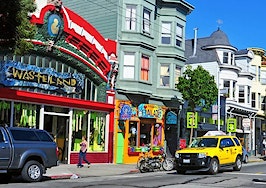- Homeowners in high-priced markets are spending more than three-quarters of their income on their mortgages and related homeownership costs, according to a new Trulia research report.
- The good news for homebuyers in expensive housing markets, however, is that the cost of pricier homes is somewhat balanced out by cheaper nonhousing essentials.
- Conversely, taking into account the typical cost of commuting and utilities, some of the most affordable markets, where homeowners spend less than 20 percent of their incomes on housing, don’t seem like as much of a bargain anymore.
Far outpacing the widely accepted guidance that Americans should spend no more than 30 percent of their income on housing costs, homeowners in high-priced markets are spending more than three-quarters of their income on their mortgages and related homeownership costs, according to a new Trulia research report.
According to the report, “Nickeled and Dimed: How Commuting Costs and Utilities Affect Middle-Class Housing Affordability,” homeowners in San Francisco are shelling out an astonishing 85.5 percent of their incomes on housing, commuting and utilities.
And homeowners in the other nine cities on the report’s top 10 list of least affordable places to live — the coastal markets of Los Angeles; Miami, San Diego, Orange County, California; San Jose, California; Ventura, California; Honolulu; Oakland, California; and Fairfield County, Connecticut — pay more than half of their salaries on housing and related costs, even if they buy a median-priced home.

“Most notably in San Francisco and Miami, the share of income needed to be spent on housing has jumped more than 15 percentage points,” said Trulia housing economist Ralph McLaughlin.
“What’s more, we found a strong positive relationship between housing affordability in September 2014 and the year-over-year change in the share of income spent on housing. In other words, the most expensive markets are getting even more expensive.”
The good news for homebuyers in expensive housing markets, however, is that the cost of pricier homes is somewhat balanced out by cheaper nonhousing essentials — which many homebuyers tend to overlook in their budgeting plans, and many economists and government housing officials sometimes fail to consider, Trulia’s report pointed out.
“‘Location, location, location’ affects not just the cost of the home itself, but also how far one must commute and spend on heating, cooling and water expenses.” – Trulia housing economist Ralph McLaughlin
“The moral of the story is that middle-class homebuyers should consider not just the price of a prospective home, but also other costs associated with the home’s location,” McLaughlin said.
“Mortgage payments, property taxes and insurance aren’t the only factors affecting housing affordability. The cost of commuting and utilities can also play a big role depending on where you live. After all, ‘location, location, location’ affects not just the cost of the home itself, but also how far one must commute and spend on heating, cooling and water expenses.”
Thus, the amount of income that homeowners in the least affordable markets spend on housing is partially offset by lower commuting and energy costs, McLaughlin said.
Conversely, taking into account the typical cost of commuting and utilities, some of the most affordable markets, where homeowners spend less than 20 percent of their incomes on housing, don’t seem like as much of a bargain anymore, Trulia said.
Those markets include:
- Akron, Dayton, Cleveland and Toledo, Ohio
- Louisville, Kentucky
- Little Rock, Arkansas
- Detroit
- Kansas City, Missouri
- Wichita, Kansas
- Indianapolis, Indiana
“For example, in five of the 10 metros with the highest share of income spent on commuting and utilities, middle-class homebuyers can actually purchase a median-price home and spend less than 31 percent of their monthly income on housing. But when taking into account commuting and utility costs, the share of income spent on housing and these nonhousing essentials jumps significantly,” McLaughlin said.
Trulia’s report is based on an examination of how much of a middle-class household’s monthly income would be spent on the monthly mortgage payment if they bought the median-priced home, based on the for-sale listings on Trulia in August, in the 100 largest U.S. metros.
Trulia assumed a 30-year fixed-rate loan at a 4 percent interest rate and included both property taxes and insurance into its calculations.
To calculate utility costs, Trulia used data from the 2013 American Community Survey (ACS) on the median monthly household expenditure on electricity, gas and water for each metro. To calculate commuting costs, Trulia also used 2013 ACS data to calculate the median household commute time to work for each metro.
The company then translated commute time into a monthly dollar amount by assuming a $7 per hour operating cost ($3.50 per gallon, 20 miles per gallon average and 40 miles per hour average speed), plus 25 percent of the local median hourly wage.







